
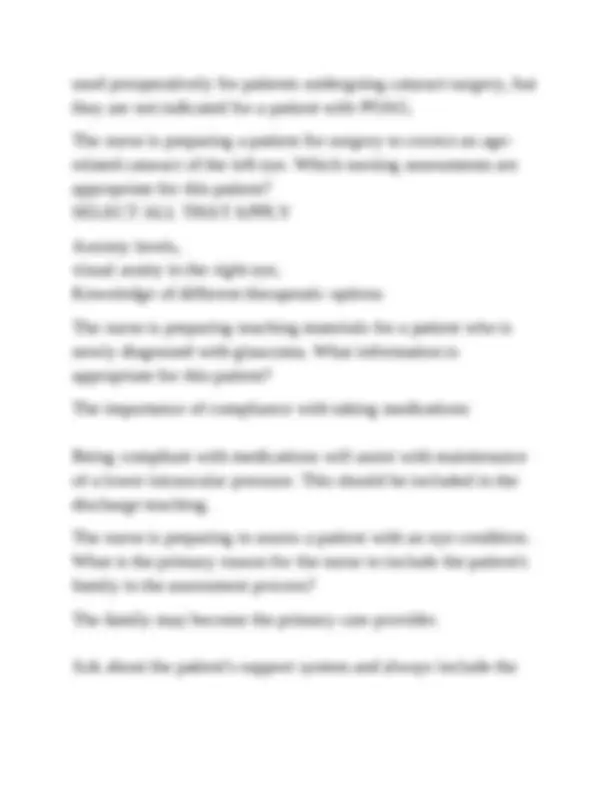
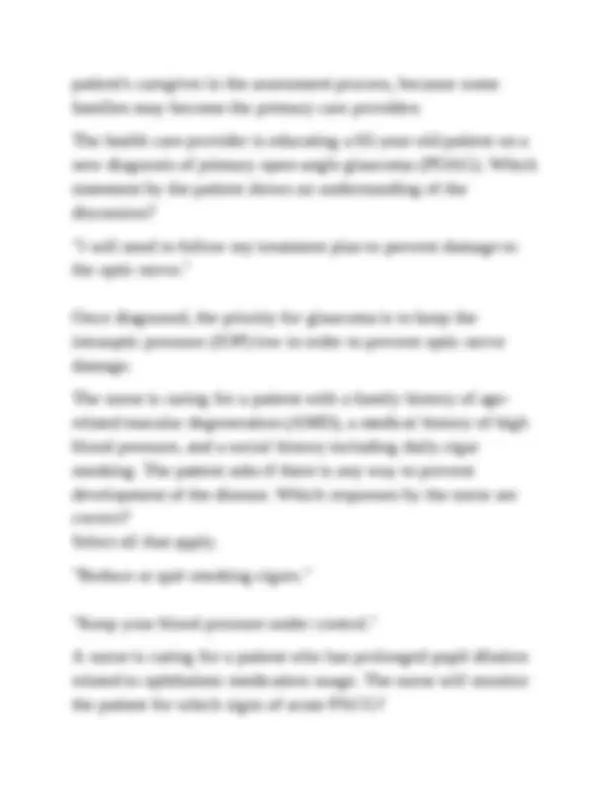
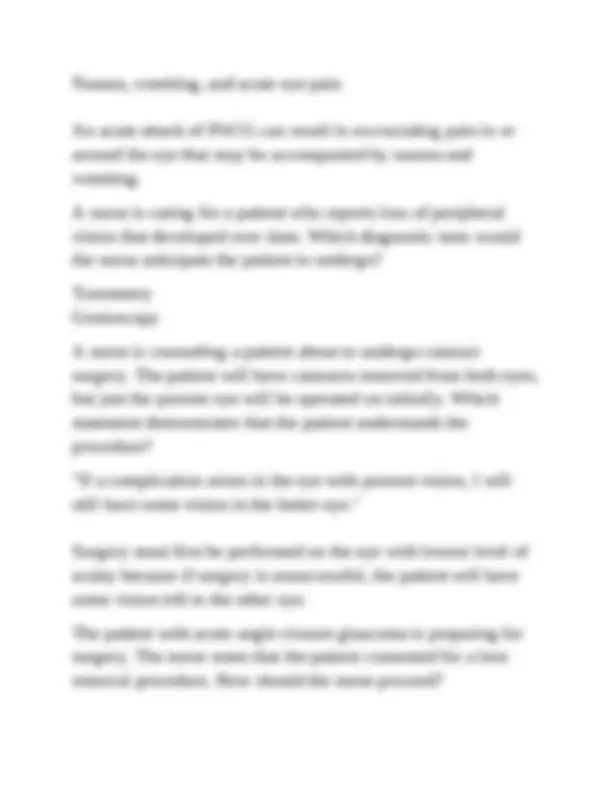
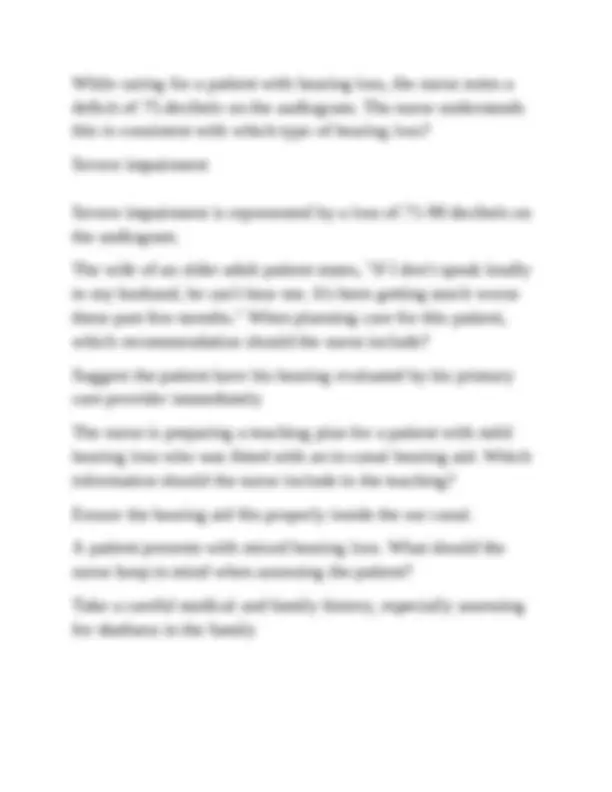
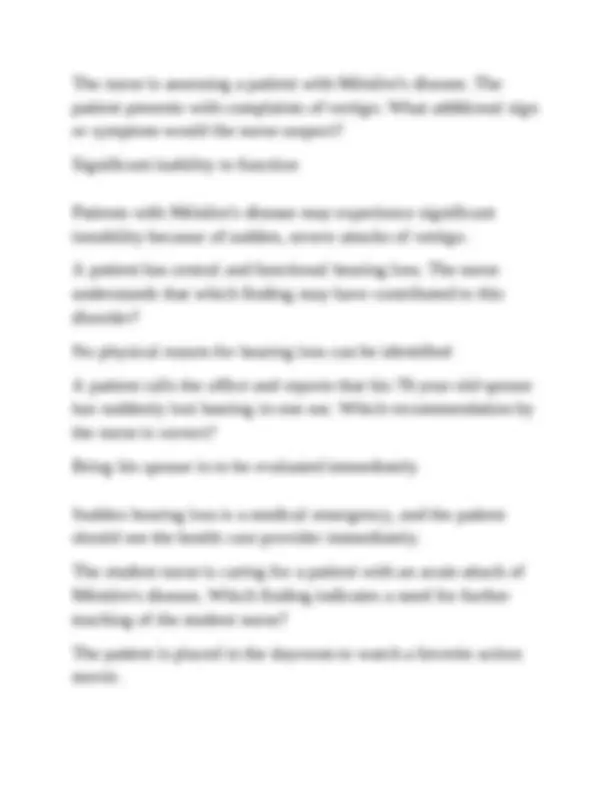
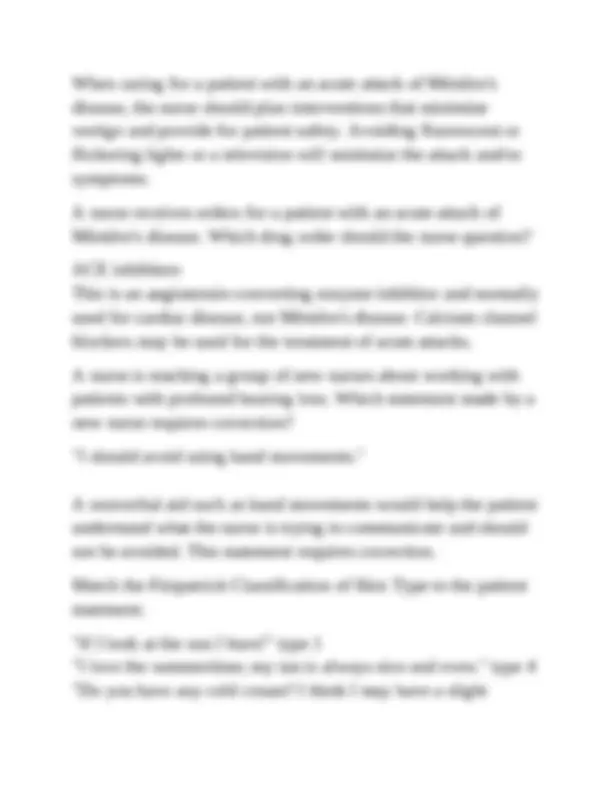
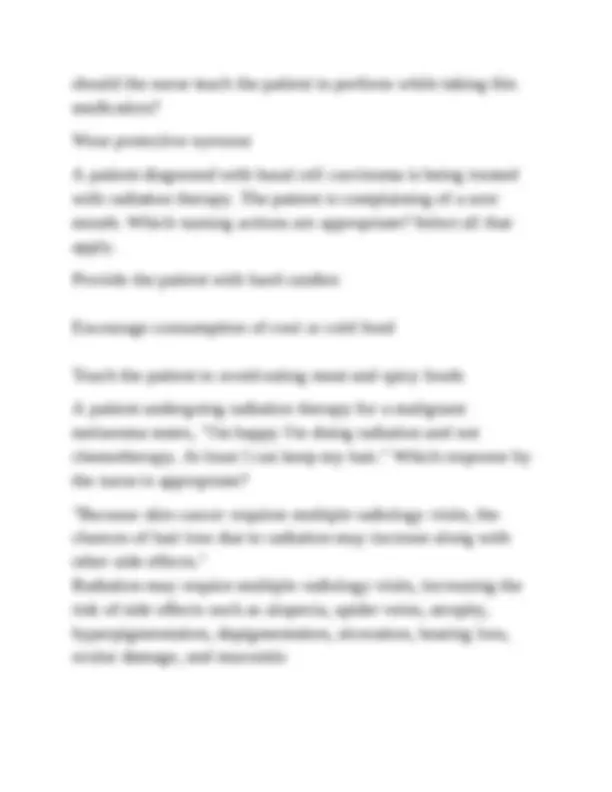
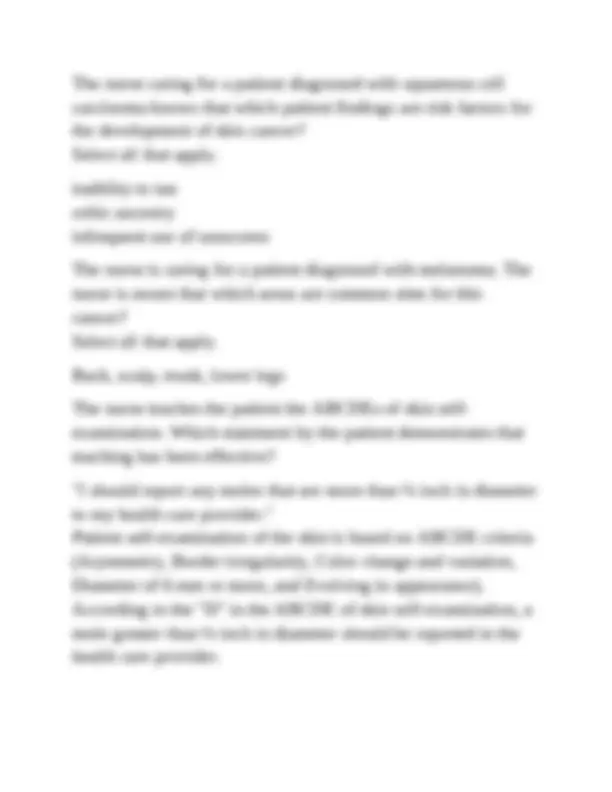
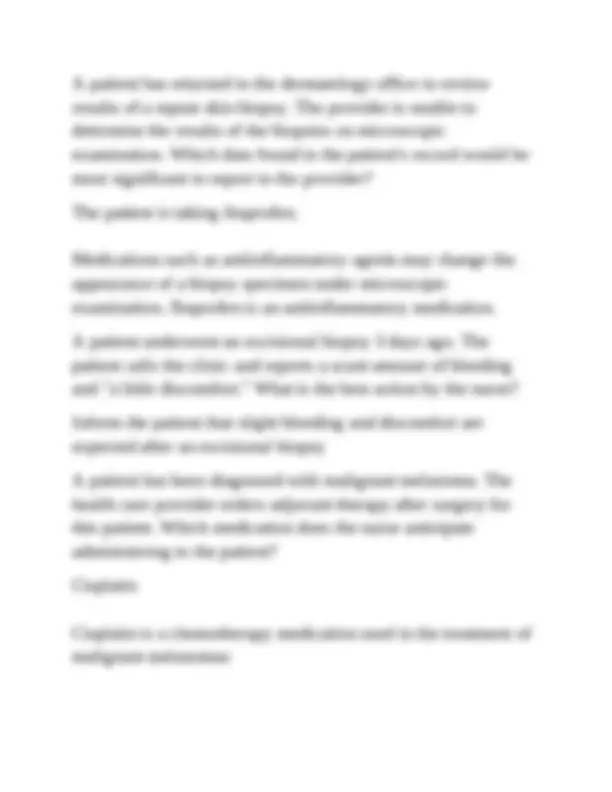
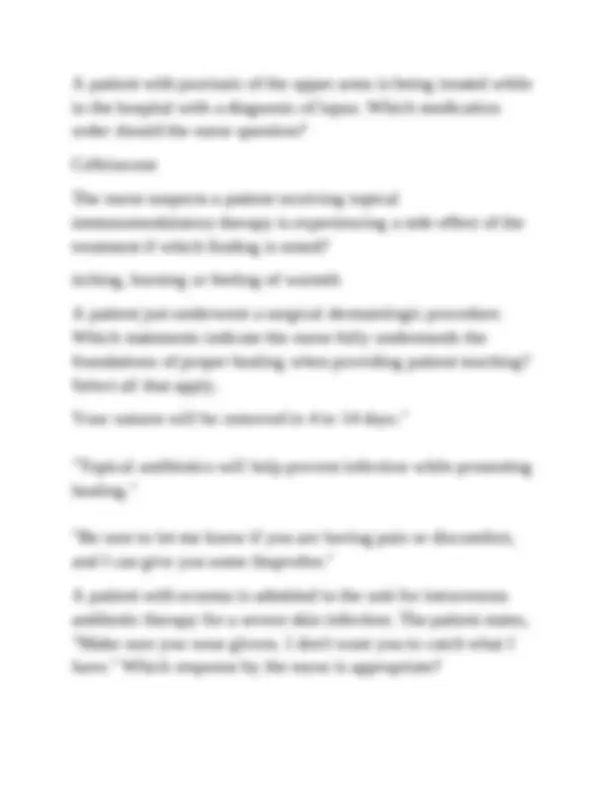
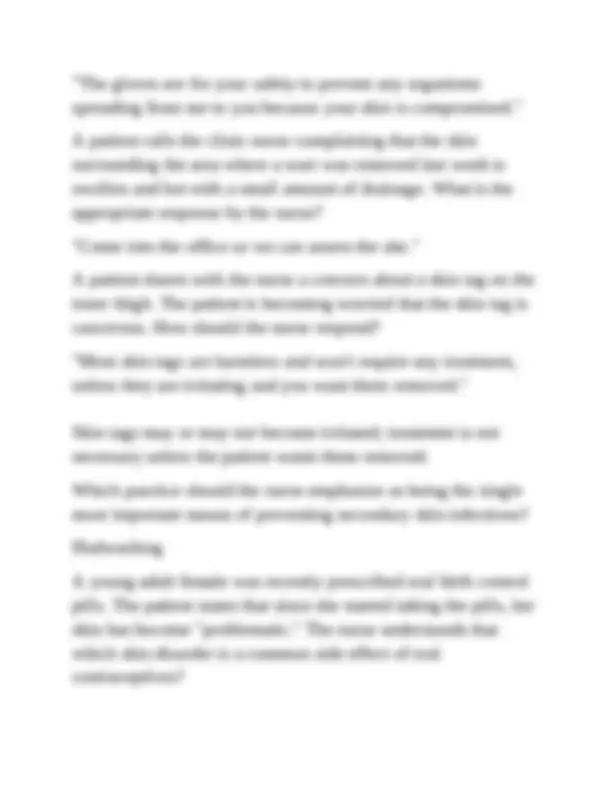
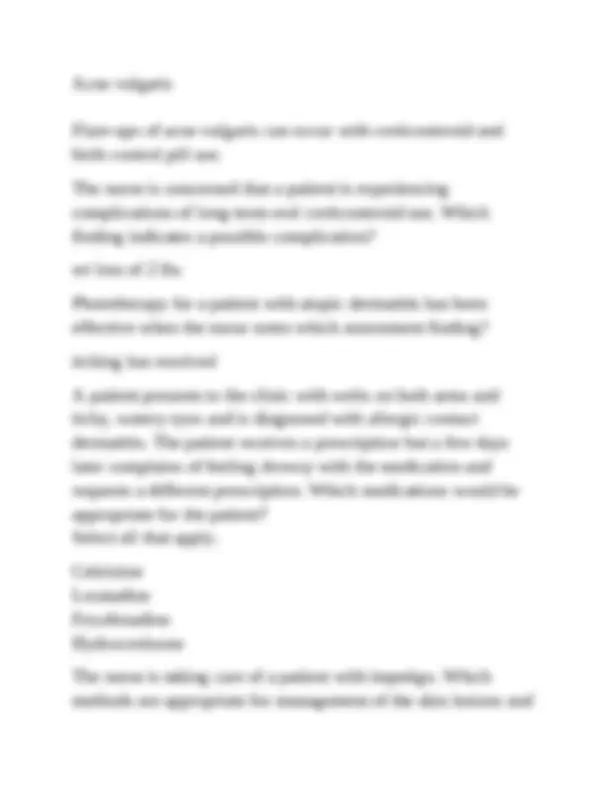
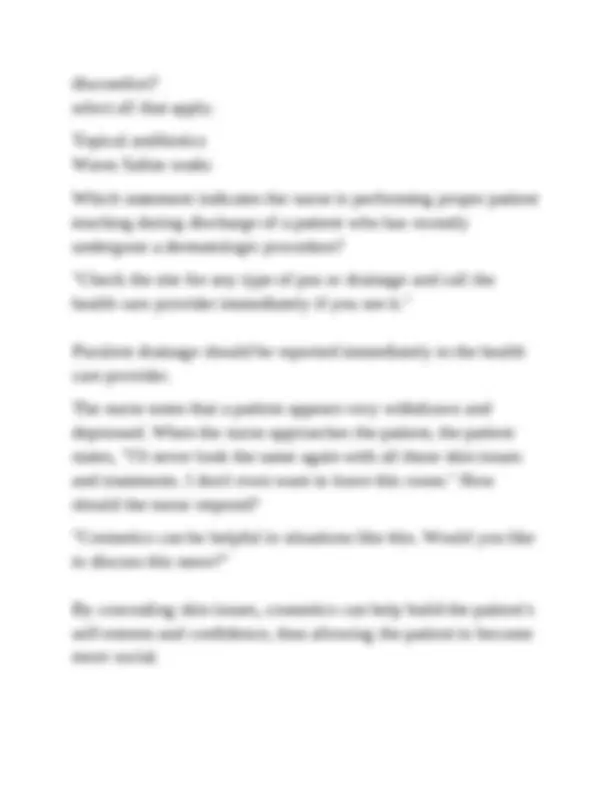
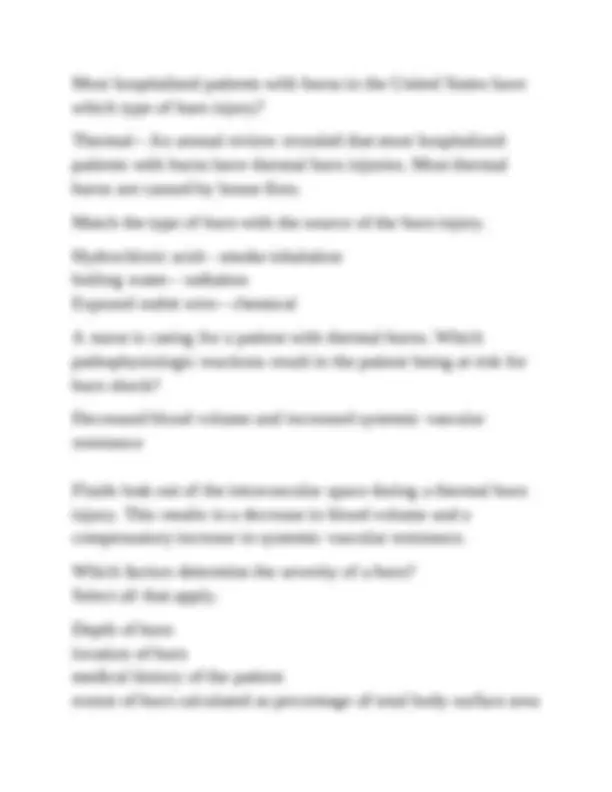
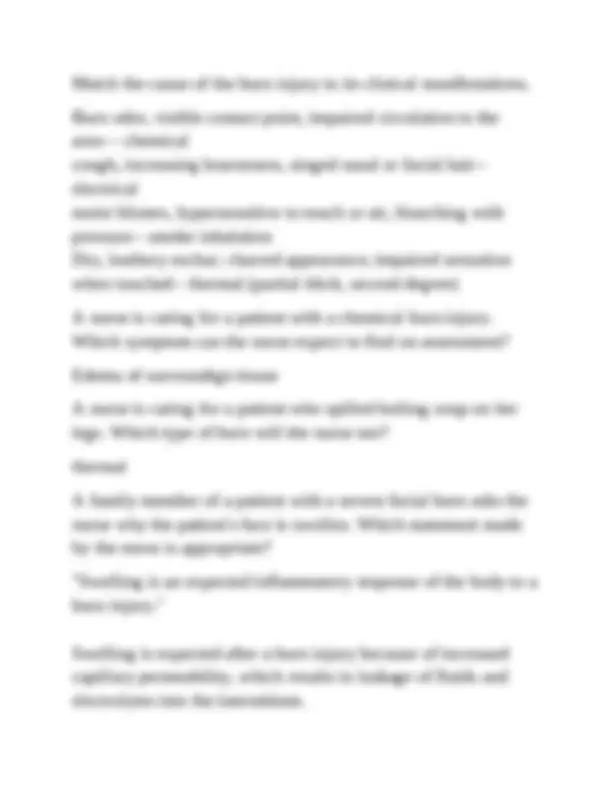
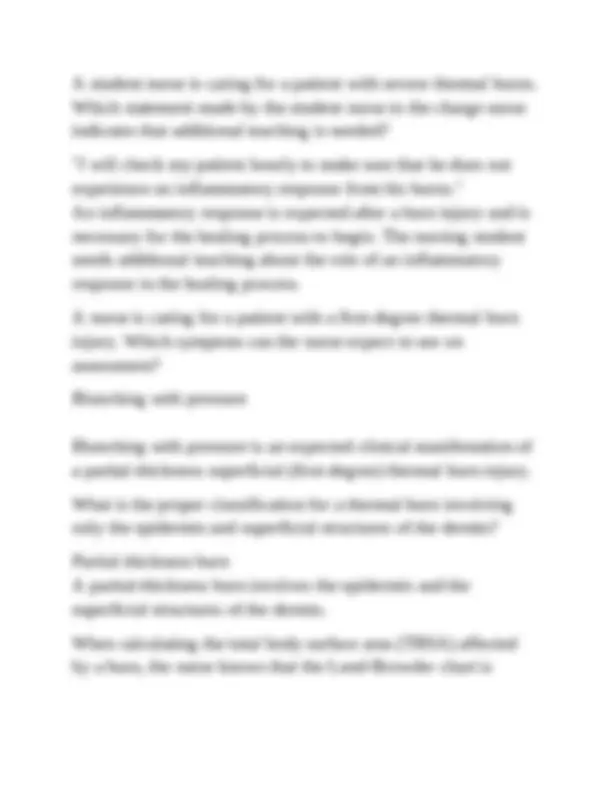
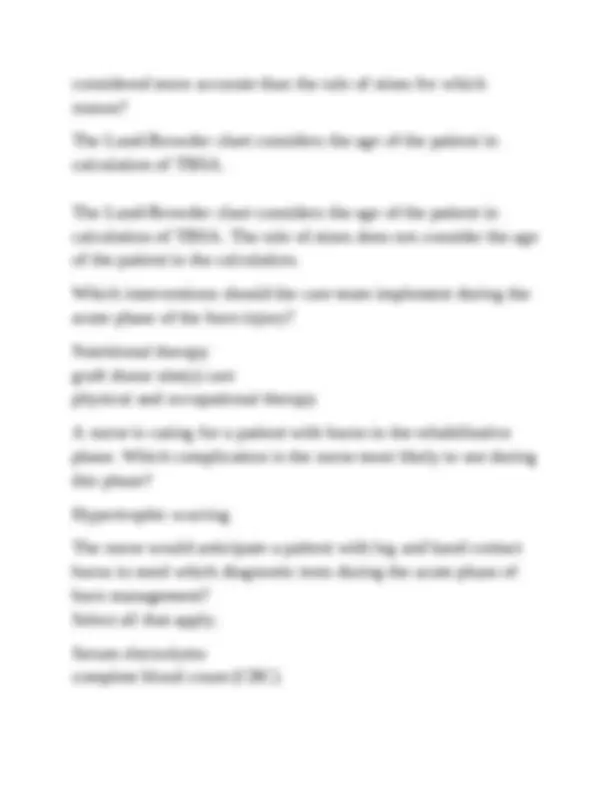
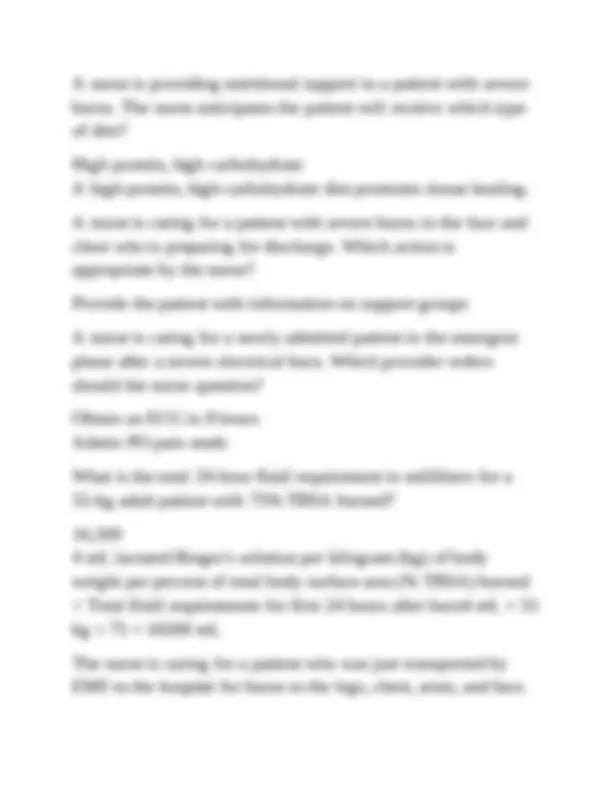
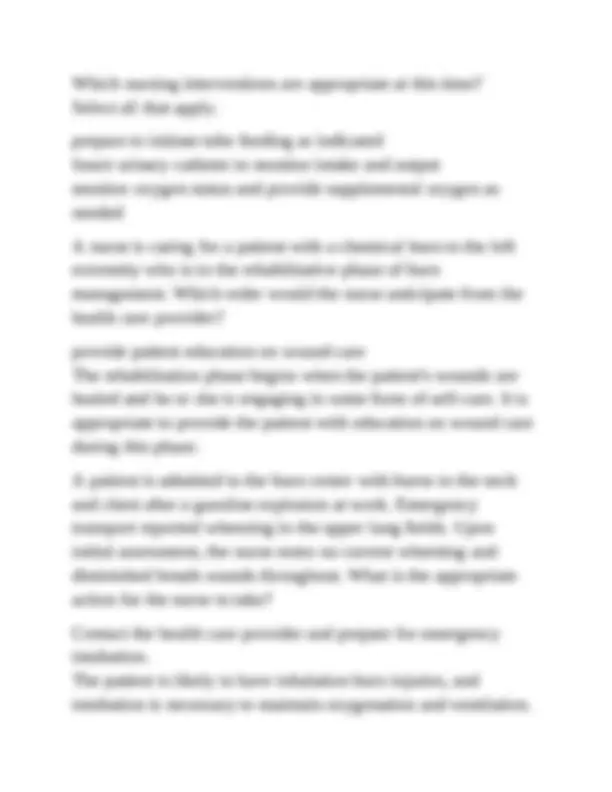
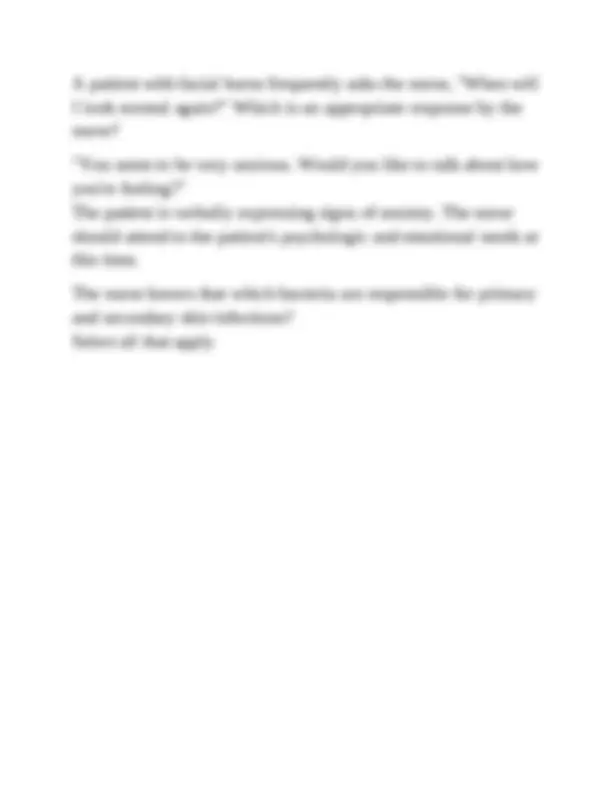


Study with the several resources on Docsity

Earn points by helping other students or get them with a premium plan


Prepare for your exams
Study with the several resources on Docsity

Earn points to download
Earn points by helping other students or get them with a premium plan
Community
Ask the community for help and clear up your study doubts
Discover the best universities in your country according to Docsity users
Free resources
Download our free guides on studying techniques, anxiety management strategies, and thesis advice from Docsity tutors
A collection of questions and answers related to med surg 3 exam 1 sherpath lessons. It covers various topics including cataracts, age-related macular degeneration (amd), glaucoma, and hearing loss. The document offers insights into risk factors, symptoms, treatment options, and nursing care for these conditions. It is a valuable resource for students preparing for med surg 3 exams.
Typology: Exams
1 / 28

This page cannot be seen from the preview
Don't miss anything!





















Which patient does the nurse identify as being at risk for developing cataracts? a 20 year old who sustained an injurt to the right eye after a car accident. Risk factor for devloping cataracts. While educating a patient with age-related macular degeneration (AMD), the nurse discusses modifiable risk factors. Which modifiable risk factor should the nurse include in the teaching? SMOKING Smoking is a modifiable risk factor that is a predisposing factor for AMD. The patient should be educated on the importance of smoking cessation. A nurse is caring for a patient newly diagnosed with open-angle glaucoma. The patient asks, "How could I possibly have glaucoma? I haven't noticed a thing." What is an appropriate response by the nurse? People with glaucoma often don't have symptoms right away, and are not aware of the disease until they are evaluated by a health care provider.
Glaucoma develops slowly and without symptoms of pain or pressure and may not be noticed until there is visual field loss. The nurse is caring for a patient with cataracts. The health care provider informs the nurse that the patient will be undergoing surgery to replace the affected lens. The nurse anticipates preparing the patient for which procedure? Keratometry and A-scan ultrasound If surgery is planned, keratometry may be performed to assess the curvature of the cornea, and an A-scan ultrasound may be done to obtain measurements for an artificial replacement lens. The nurse is developing a nutritional plan for a patient at risk for age-related macular degeneration (AMD). Which food item should the nurse encourage in the patient's diet? Kale salad Eating dark-green and leafy vegetables, which are rich in lutein, may aid in reducing the risk of AMD in people at higher risk. A nurse is caring for a patient with a new diagnosis of primary open-angle glaucoma (POAG). When reviewing the health care provider's orders, which prescription should the nurse question? Ibuprofen Nonsteroidal antiinflammatory drugs, such as ibuprofen, may be
patient's caregiver in the assessment process, because some families may become the primary care providers The health care provider is educating a 65-year-old patient on a new diagnosis of primary open-angle glaucoma (POAG). Which statement by the patient shows an understanding of the discussion? "I will need to follow my treatment plan to prevent damage to the optic nerve." Once diagnosed, the priority for glaucoma is to keep the intraoptic pressure (IOP) low in order to prevent optic nerve damage. The nurse is caring for a patient with a family history of age- related macular degeneration (AMD), a medical history of high blood pressure, and a social history including daily cigar smoking. The patient asks if there is any way to prevent development of the disease. Which responses by the nurse are correct? Select all that apply. "Reduce or quit smoking cigars." "Keep your blood pressure under control." A nurse is caring for a patient who has prolonged pupil dilation related to ophthalmic medication usage. The nurse will monitor the patient for which signs of acute PACG?
Nausea, vomiting, and acute eye pain An acute attack of PACG can result in excruciating pain in or around the eye that may be accompanied by nausea and vomiting. A nurse is caring for a patient who reports loss of peripheral vision that developed over time. Which diagnostic tests would the nurse anticipate the patient to undergo? Tonometry Gonioscopy A nurse is counseling a patient about to undergo cataract surgery. The patient will have cataracts removed from both eyes, but just the poorest eye will be operated on initially. Which statement demonstrates that the patient understands the procedure? "If a complication arises in the eye with poorest vision, I will still have some vision in the better eye." Surgery must first be performed on the eye with lowest level of acuity because if surgery is unsuccessful, the patient will have some vision left in the other eye. The patient with acute angle-closure glaucoma is preparing for surgery. The nurse notes that the patient consented for a lens removal procedure. How should the nurse proceed?
The nurse is caring for a patient with age-related macular degeneration (AMD) and refers the patient to a psychologist. Which responses by the nurse are appropriate when the patient questions the reason for the referral? Select all that apply. "The permanent loss of central vision can be very difficult." "This is done to discuss the need for additional support systems." A patient in the emergency department is diagnosed with Ménière's disease after an acute episode and asks the nurse how long the attack will last. What is the nurse's correct response? "These attacks can last for hours to days." Attacks of Ménière's disease can last for hours or days and may occur several times a year. A nurse is caring for a patient with hearing loss. The patient asks the nurse what it means to have sensorineural hearing loss. Which response from the nurse is correct? "It is an impairment of one of your cranial nerves that affects the function of your ear." Sensorineural hearing loss is caused by impairment of function of the inner ear or the vestibulocochlear nerve (CN VII).
While caring for a patient with hearing loss, the nurse notes a deficit of 75 decibels on the audiogram. The nurse understands this is consistent with which type of hearing loss? Severe impairment Severe impairment is represented by a loss of 71-90 decibels on the audiogram. The wife of an older adult patient states, "If I don't speak loudly to my husband, he can't hear me. It's been getting much worse these past few months." When planning care for this patient, which recommendation should the nurse include? Suggest the patient have his hearing evaluated by his primary care provider immediately The nurse is preparing a teaching plan for a patient with mild hearing loss who was fitted with an in-canal hearing aid. Which information should the nurse include in the teaching? Ensure the hearing aid fits properly inside the ear canal. A patient presents with mixed hearing loss. What should the nurse keep in mind when assessing the patient? Take a careful medical and family history, especially assessing for deafness in the family
When caring for a patient with an acute attack of Ménière's disease, the nurse should plan interventions that minimize vertigo and provide for patient safety. Avoiding fluorescent or flickering lights or a television will minimize the attack and/or symptoms. A nurse receives orders for a patient with an acute attack of Ménière's disease. Which drug order should the nurse question? ACE inhibitors This is an angiotensin-converting enzyme inhibitor and normally used for cardiac disease, not Ménière's disease. Calcium channel blockers may be used for the treatment of acute attacks. A nurse is teaching a group of new nurses about working with patients with profound hearing loss. Which statement made by a new nurse requires correction? "I should avoid using hand movements." A nonverbal aid such as hand movements would help the patient understand what the nurse is trying to communicate and should not be avoided. This statement requires correction. Match the Fitzpatrick Classification of Skin Type to the patient statement. "If I look at the sun I burn!" type 1 "I love the summertime; my tan is always nice and even." type 4 "Do you have any cold cream? I think I may have a slight
sunburn." type 3 "I look like a lobster now, but in a couple of days my tan should look decent." type 2 A patient with a new diagnosis of actinic keratosis is admitted to the unit. On assessment, which clinical manifestations would the nurse expect to find? Thickened papules on the skin Actinic keratosis is a precancerous lesion characterized by thickened hyperkeratotic papules and plaques on sun-exposed areas. A patient in the clinic states, "I found this reddish brown mole on my scalp. It can't be cancer: I only sunbathe twice a year." The nurse understands that this characteristic finding is common in which type of skin cancer? Atypical nevi A single atypical nevus (mole) can include a variety of colors and is commonly found on the back, scalp, or buttocks. A patient arrives at the primary care clinic. The patient expresses concern about a "new mole" on the upper thigh. The nurse anticipates which initial order from the primary care provider? Prepare the patient for a biopsy
should the nurse teach the patient to perform while taking this medication? Wear protective eyewear A patient diagnosed with basal cell carcinoma is being treated with radiation therapy. The patient is complaining of a sore mouth. Which nursing actions are appropriate? Select all that apply. Provide the patient with hard candies Encourage consumption of cool or cold food Teach the patient to avoid eating meat and spicy foods A patient undergoing radiation therapy for a malignant melanoma states, "I'm happy I'm doing radiation and not chemotherapy. At least I can keep my hair." Which response by the nurse is appropriate? "Because skin cancer requires multiple radiology visits, the chances of hair loss due to radiation may increase along with other side effects." Radiation may require multiple radiology visits, increasing the risk of side effects such as alopecia, spider veins, atrophy, hyperpigmentation, depigmentation, ulceration, hearing loss, ocular damage, and mucositis
The nurse caring for a patient diagnosed with squamous cell carcinoma knows that which patient findings are risk factors for the development of skin cancer? Select all that apply. inability to tan celtic ancestry infrequent use of sunscreen The nurse is caring for a patient diagnosed with melanoma. The nurse is aware that which areas are common sites for this cancer? Select all that apply. Back, scalp, trunk, lower legs The nurse teaches the patient the ABCDEs of skin self- examination. Which statement by the patient demonstrates that teaching has been effective? "I should report any moles that are more than ¼ inch in diameter to my health care provider." Patient self-examination of the skin is based on ABCDE criteria (Asymmetry, Border irregularity, Color change and variation, Diameter of 6 mm or more, and Evolving in appearance). According to the "D" in the ABCDE of skin self-examination, a mole greater than ¼ inch in diameter should be reported to the health care provider.
Which nursing interventions are most appropriate for a patient receiving psoralen therapy? Select all that apply. Provide skin moisturizers, admin ondansetron as ordered, Recommend the use of an emollient A patient with skin cancer undergoing radiation therapy tells the nurse that she has become self-conscious about changes in her skin. What recommendations can the nurse make to the patient so that she can avoid further skin damage? "Wear a scarf on your head to protect your scalp." "Find some activities that will help you reduce stress levels." "Use gentle, nonirritating soaps when you wash your hands and bathe." The nurse is most concerned about the administration of psoralen to which patient? A patient with alcohol-related liver disease Psoralen should be used with extreme caution in patients with liver and/or renal disease.
The nurse knows that which bacteria are responsible for primary and secondary skin infections? Select all that apply Staph aureus Group A B-hemolytic strepococci A patient recently diagnosed with a bacterial skin infection exclaims, "I've never had so much as a cold!" Which statement by the nurse is the most appropriate? "Good hygiene practices can help prevent skin infections." The nurse understands that which clinical manifestations are consistent with a diagnosis of shingles? Linear rash with red pustules-- Shingles (herpes zoster) is a reactivation of the chicken pox virus with a characteristic linear distribution. Burning and itching on the trunk or lumbar area Shingles--(herpes zoster) is characterized by itching and/or burning pain on the trunk, face, and lumbosacral areas. A patient presents to the emergency department with a small, plaque-like lesion on the right arm. The patient states, "I don't know what this is, but I want it removed." Which order by the health care provider should the nurse anticipate? a kin scraping
"The gloves are for your safety to prevent any organisms spreading from me to you because your skin is compromised." A patient calls the clinic nurse complaining that the skin surrounding the area where a wart was removed last week is swollen and hot with a small amount of drainage. What is the appropriate response by the nurse? "Come into the office so we can assess the site." A patient shares with the nurse a concern about a skin tag on the inner thigh. The patient is becoming worried that the skin tag is cancerous. How should the nurse respond? "Most skin tags are harmless and won't require any treatment, unless they are irritating and you want them removed." Skin tags may or may not become irritated; treatment is not necessary unless the patient wants them removed. Which practice should the nurse emphasize as being the single most important means of preventing secondary skin infections? Hndwashing A young adult female was recently prescribed oral birth control pills. The patient states that since she started taking the pills, her skin has become "problematic." The nurse understands that which skin disorder is a common side effect of oral contraceptives?
Acne vulgaris Flare-ups of acne vulgaris can occur with corticosteroid and birth control pill use. The nurse is concerned that a patient is experiencing complications of long-term oral corticosteroid use. Which finding indicates a possible complication? wt loss of 2 lbs Phototherapy for a patient with atopic dermatitis has been effective when the nurse notes which assessment finding? itching has resolved A patient presents to the clinic with welts on both arms and itchy, watery eyes and is diagnosed with allergic contact dermatitis. The patient receives a prescription but a few days later complains of feeling drowsy with the medication and requests a different prescription. Which medications would be appropriate for the patient? Select all that apply. Cetirizine Loratadine Fexofenadine Hydrocortisone The nurse is taking care of a patient with impetigo. Which methods are appropriate for management of the skin lesions and